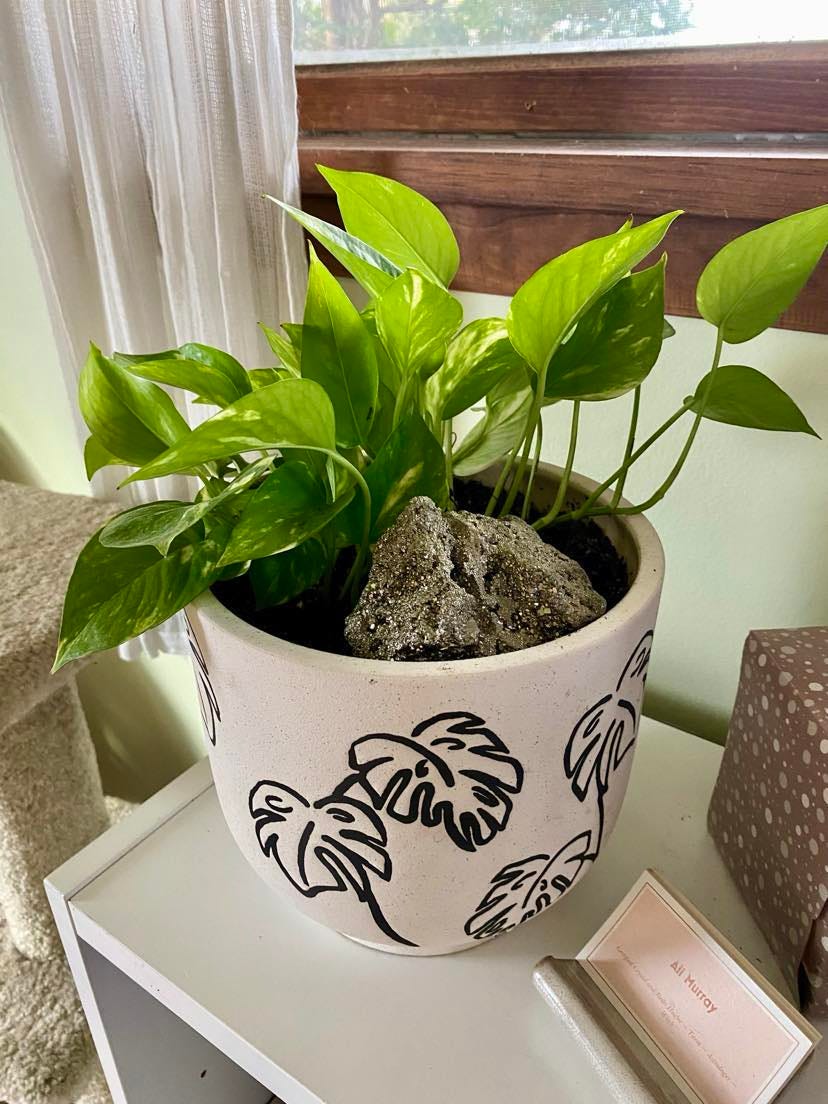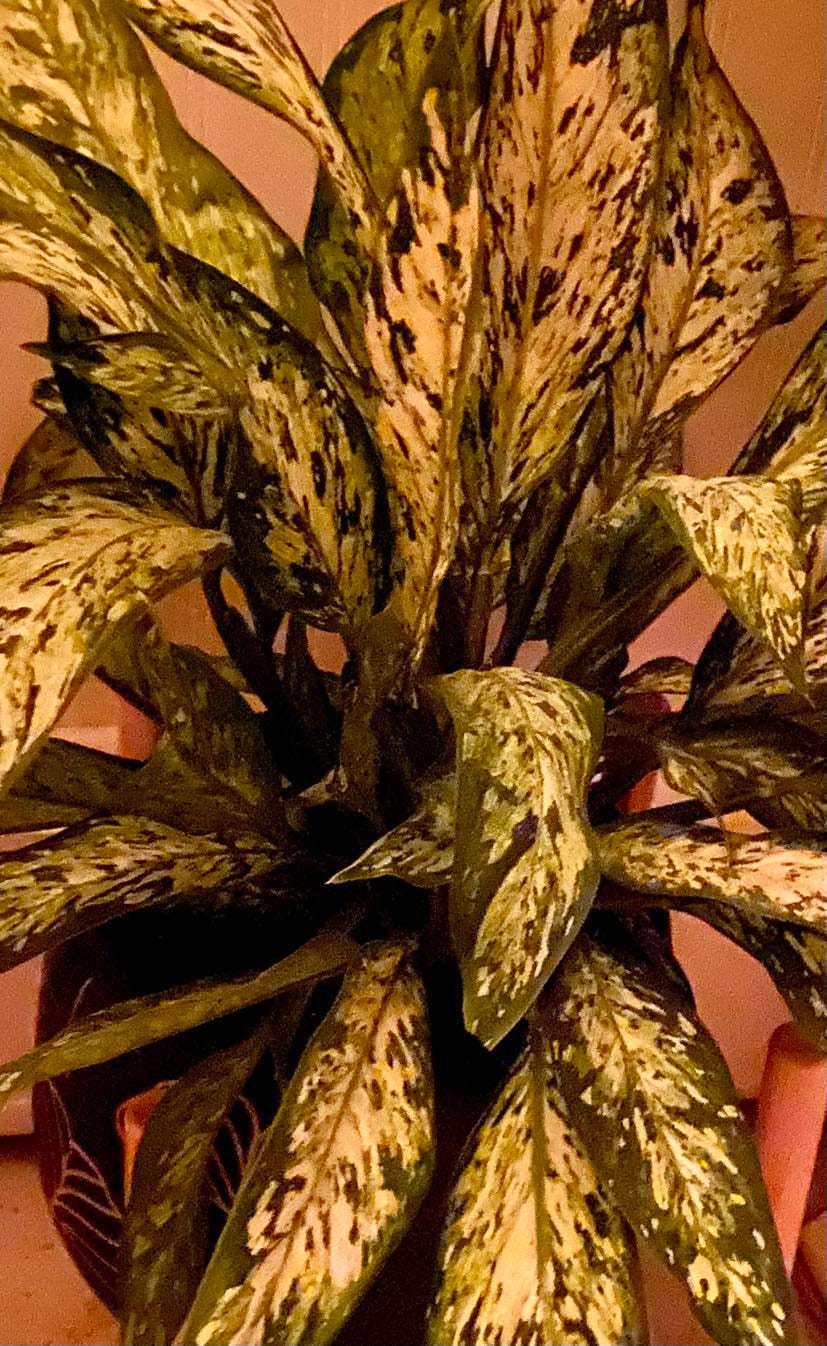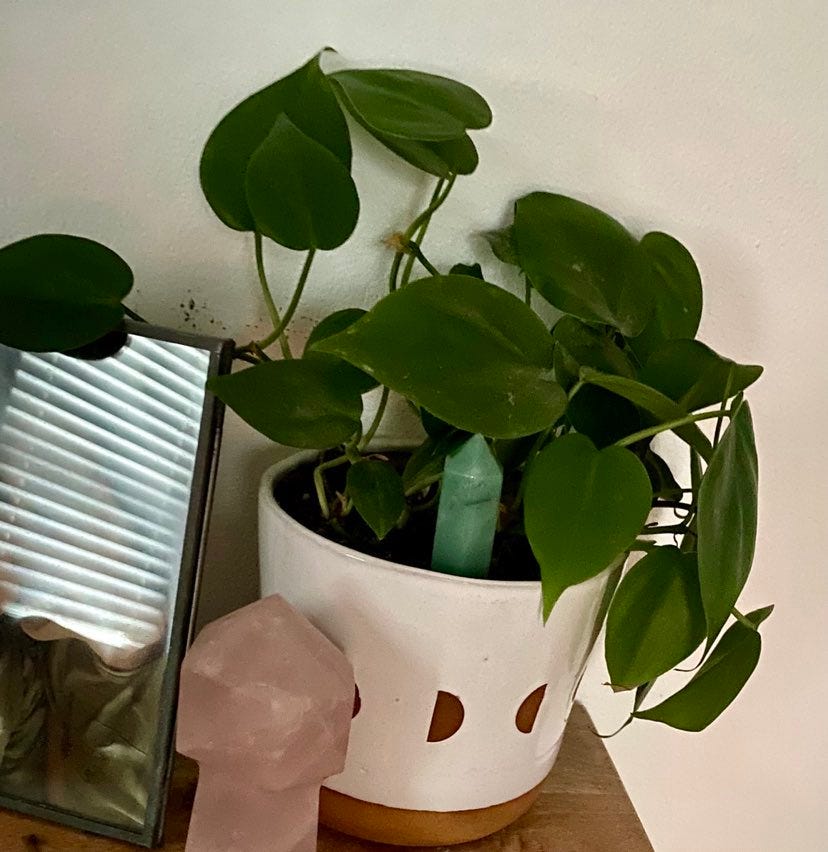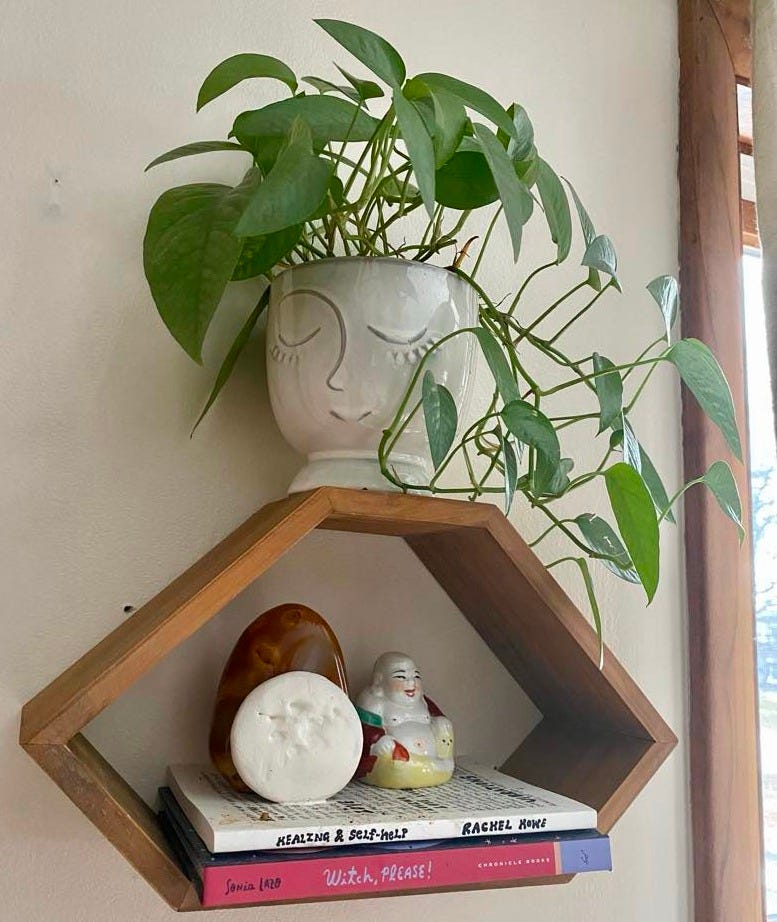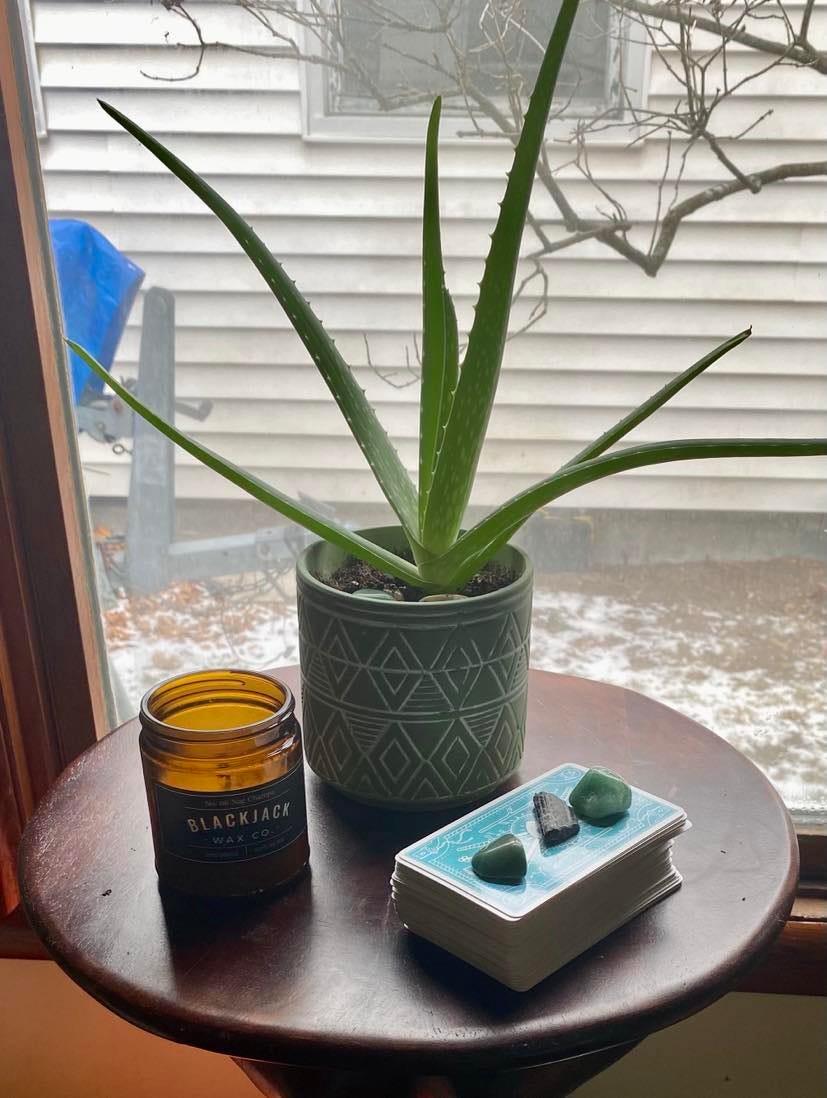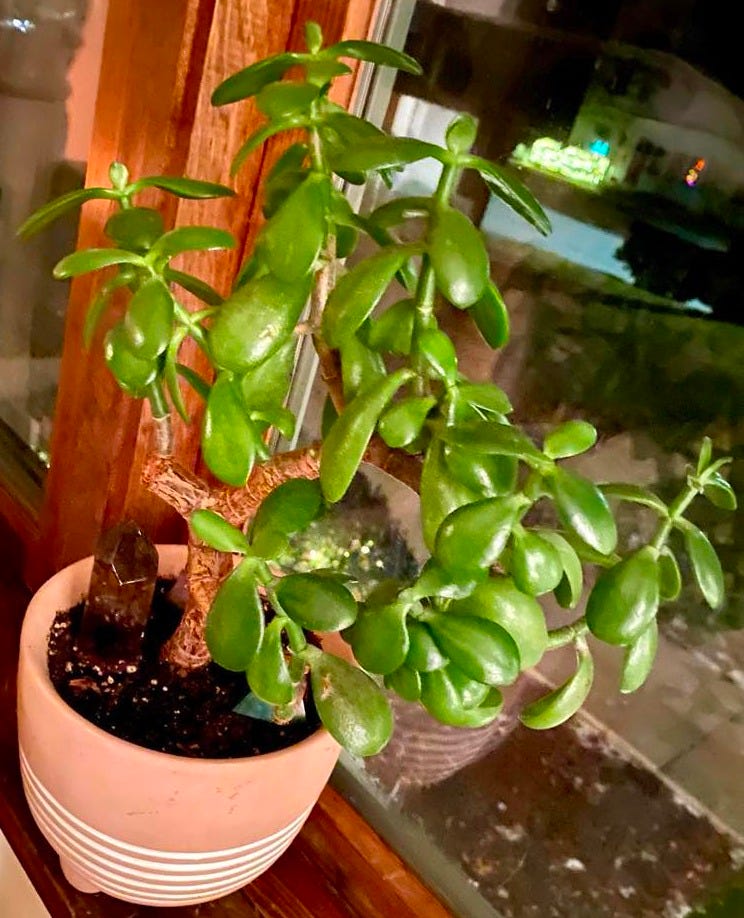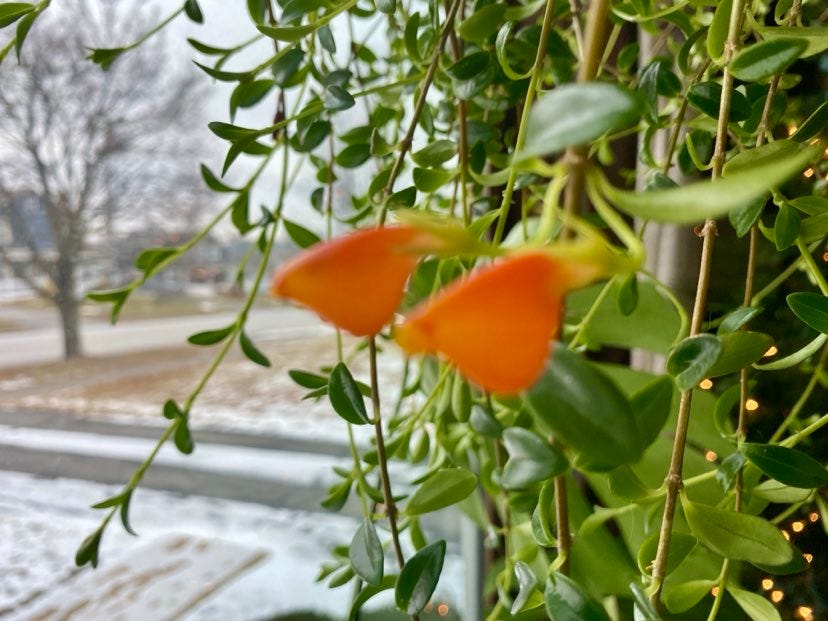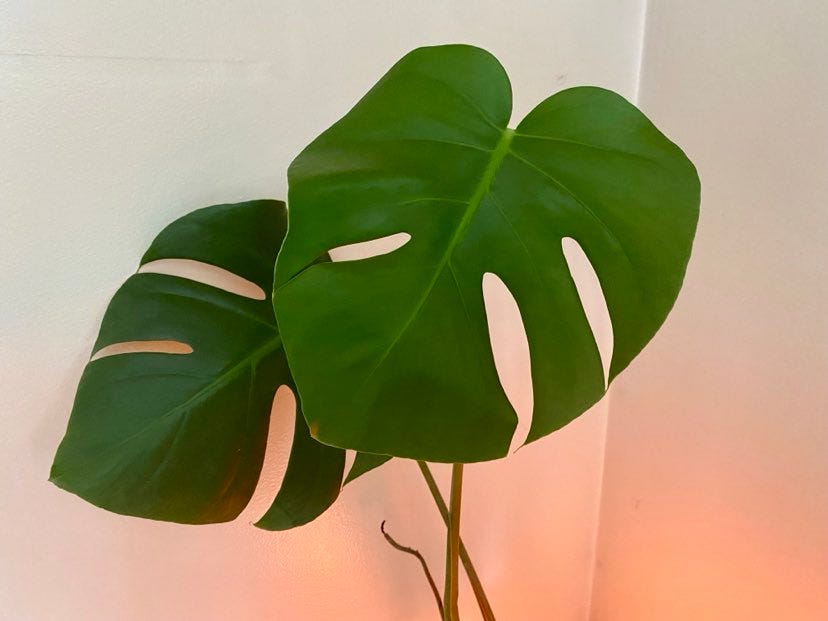Houseplant Magick
Hey, witches!
It’s January! Imbolc is quickly approaching, and as I type, big, chunky snowflakes are falling outside my living room window. I have a frothy latte in a big red mug, my cozy onesie on, and lo-fi playing on YouTube in the background. It’s really quite a vibe!
Let me ask you something: Do you have a plant? Or perhaps even many plants? Or are you more of a Carrie Bradshaw type, a self-proclaimed serial plant murderer who won’t even open your heart to a laidback ZZ?
If you fall into the latter category – hear me out – know that plants are magickal. Witches work with plant spirits in many ways – i.e. concentrated essential oils, store-bought floral arrangements, or utilizing fresh herbs and vegetables in cooking – but one of the most effective ways to work with plant spirits is to invite the living organism into your home, to actively set intentions with them and learn from their adaptability, beauty and grace.
Everyone knows that plants are “good Feng Shuai” – the energy they bring to a space is earthy, vibrant and prosperity-inducing. Our relationship with plants is symbiotic – they create the oxygen we need to breathe and conversely, plants require carbon dioxide for photosynthesis, making us natural and mutually-beneficial living companions. Plants are calming, visually striking, and many species purify the air (which is so important this time of year!) Where I live in Upstate NY, the first signs of growth come late into spring – our growing season is unbelievably short. All houseplants have ancestors which lived and thrived outside; they bring that abundant earth magick into the comfort of our indoor spaces year-round (even the 7 + months where it isn’t available outside.) Developing a relationship with plants is inherently a magickal practice – over time, we learn to communicate with these earthly beings, to intuit their needs by their growth patterns, foliage and soil – but we can also work with plants to manifest our magickal intentions (they’re usually quite happy to help!)
Here are a few of my tips for practicing houseplant magick, along with some of my favorite plants in my home (and how I work with them.)
· Introduce them to your crystals. Like people and plants, the green world and gemstones have a natural affinity and can boost each other’s health, vibration and symbolism. Green Aventurine, Jade, Moss Agate, Clear Quartz, Green Garnet and Malachite love plants; tuck them right into the planter to stimulate growth and promote wellness. When pairing your plants with crystal allies, you can also consider their care needs, basic properties or planetary correspondences: Heliotropes and sun-loving plants do well with heat-treated amethyst or sunstone in their soil (which carry the warming energies of the sun’s rays) while traditionally “lunar” plants like succulents vibe with moonstone or selenite. If you’re working with a plant to manifest specific energies or intentions, select a gemstone which resonates with that particular spell-work — place a smoky quartz in the dumb cane by your door, a pyrite in your Pothos or a rose quartz sphere in the Heartleaf Philodendron on your love altar. In addition to tucking a crystal carving, sphere or tumbled stone right into your plant’s soil, you can also feed your plants gemstone-infused water — make a quickie elixir out of distilled or filtered spring water by leaving it to charge with your chosen stone for 24-48 hours. I feed my plants water infused with purifying Shungite, simply leaving the stone in my watering jug all the time. But tucking beautiful crystals into your pots to enchant the soil is both visually striking and metaphysically powerful!
My prosperity Pothos
· Lean on your intuition. It can be so tempting to overthink plant care (i.e., Googling your plants to diagnose every curled leaf or burnt tip, or using an app to schedule timed alerts for watering.) I’m not saying not to research the care needs of your plants (I love a good hack, tip or trick – if you have a trusted source, online plant experts can be really helpful.) The problem? A lot of these apps and online sources give automated diagnoses – not to say they’re inaccurate, but their feedback is super generalized and doesn’t consider your plant’s unique living conditions (or their individual personality – yes, plants are people too!) Especially with AI-generated google responses, a lot of the information on the internet is simply inaccurate – researching the same plant can yield starkly different takes on how best to care for it (and the time of year, the area in which you live, and the plant’s location in your home are all crucial data points for appropriately timing waterings and diagnosing common ailments.) Frustratingly, over-watering and under-watering produce exactly the same symptoms (i.e. sad, distressed-looking foliage) so while of course you want to follow up when a plant seems compromised, I wouldn’t recommend googling their symptoms (much like I don’t recommend googling your own.) Ask yourself: How is the temperature of the room? Is the plant right next to a heat source, or a drafty window? Is it not receiving enough light (or too much?) Is it a very dry environment, like mine? (In which case, a leaf mister or humidifier may do the trick!) Is the soil moist? As a recovering over-waterer, I recommend getting a moisture meter for $8 on Amazon (you can also just feel the soil, but I’m an Aquarius and appreciate a numerical evaluation!) When your instinct is to look outside for answers — to Google or snap a diagnostic photo — drop in and begin dialogue with the spirit of your plant instead. Regardless of whether you consider yourself a green thumb, this is a practice which takes time, patience, and a willingness to sometimes get it wrong. Avoid relying on pre-set watering alarms which -- IMO -- completely take the joy out of allowing your plants to just tell you what their needs are (a much more accurate barometer!) The longer you intentionally caretake and cohabitate with a plant, the more familiar you become with it’s unique cues (how they look when happy and healthy – and the signals they send when they’re over vs. under-watered, sun deprived or otherwise upset.) Cultivating a relationship with your plant(s) is a grounding activity and an exercise in developing your intuition, and like any relationship, it also promotes self-awareness (with plants serving as more gentle teachers than our fellow humans tend to be!) Caring for my houseplants illuminated some of the quirky relationship habits I otherwise wouldn’t have been aware of (like the tendency to over-nurture, which in the plant world, corresponds to being an over-waterer!) I also observed perfectionist tendencies – at the beginning, my desire to care for them “correctly” often overshadowed my gut feelings (which compromised my ability to hear them and communicate with them effectively.)
· Not all spaces are suitable for all plants -- and not all people and plants are compatible. This is a controversial statement but IMO, there’s no getting around this fundamental truth. While a quick google search can tell you whether a particular plant is “recommended for beginners”, you may notice a more natural affinity with some plants than others – and whether it’s a lack of compatibility or something about the environment that isn’t suitable, you may notice certain species really struggle to survive in your space (while others of equal “difficulty” seem to just thrive!) I have killed every Calathea I’ve brought into my home – and because I like a challenge, that’s more than I’d like to admit! On the other hand, my green witch potential is fully realized with Jade Plants, Ferns, and many other species widely regarded as “fussy.” While my home is bright, I have limited real estate which provides prolonged direct sunlight – I’ve had no luck growing Lavender, and I’ve also killed a Croton or two. I know which plants I’m most effective at caring for – it’s as though we just get along! – and I know which ones I really struggle to communicate with, or simply don’t have a good location in my home for. Much of this is about learning the conditions of your space: If you don’t have a lot of bright windows, I wouldn’t recommend a succulent, while if your home is really dry, you’ll struggle with humidity-lovers like Ferns, Calathea or Monstera. While I can always find a spot for a plant that captures my eye or intuitively speaks to me, it’s worth considering the space you’re trying to fill – how much sun it gets, whether the kittens can get to it, etc. (although sometimes, it simply comes down to trial-and-error.) And if, like me, you repeatedly kill the same plant, don’t feel bad! If you’re committed to mastering the lessons of this particularly challenging teacher, try again – actively learn, listen and implement a new approach (i.e. more or less water, a different location, adding a grow light, etc.) Like any relationship, we sometimes have to work at our dynamic with a plant — and if you aren’t willing to do that (or the heartbreak is too much), stick to the allies which respond best to you and your space. I secretly think people who allege not to have a “green thumb” just haven’t found the plant(s) which vibe with them, and they’re still nursing the heartbreak of a casualty. In reality, every plant is dramatically different in their needs and self-expression – giving up on the entire plant kingdom because of one fussy Fiddleleaf Fig is like abandoning the pursuit of love following a bad date. And if you’re really in doubt about your green witch potential – or you’d like a gentle re-intro post-heartbreak -- get thee a Pothos! They’re stunning, low-maintenance, and incredibly resilient to neglect.
· Pay attention to the planets. The moon moves through a different zodiac sign every 2-3 days, and just as it’s phase and location affect the human body and psyche, so too do they influence our plant pals. Ideally, sync your waterings to the moon’s transits through Cancer, Scorpio or Pisces (the plant’s root system will absorb the moisture more easily.) If you need to re-pot, time it to the moon’s transit through an earth sign for minimal stress (i.e. Taurus, Virgo or Capricorn.) You can also pay attention to the moon’s phase for your plant care cues: Ideally, time watering and re-potting to the waning moon phase (the 7-day period between the Full Moon and third quarter); prune dead or diseased leaves between the New and First Quarter Moons to promote healthy new growth (while if you’ve got an unruly vine or an out-of-control Monstera and want to control growth, prune a few days before the Dark Moon.) We all “communicate” with our plants better when Mercury transits Taurus (a roughly once-a-year transit which lasts about two weeks.) Take advantage of this transit to check in with your plants, assessing their overall wellness and – if needed -- making major adjustments to your care routines. Venus or Mercury in Taurus are the best times to re-organize your plant scheme or introduce new allies (and it’s even better if these transits overlap, as they sometimes do!)
My Stromanthe, showing off the pink undersides of her leaves come nightfall!
Here are a few of my favorite allies!
Dumb Cane
If you’re a sucker for variegation like me, you’ll love the lush, vibrant and easy-to-care-for Dumb Cane! Having one in your home is a protection spell, so it’s the perfect plant to leave by the front door (or in the bathroom, as they love humidity.) Dumb Cane will adjust to many different light conditions and doesn’t need much – my south-facing bathroom is bright but gets very little direct light (and this beauty is thriving beneath my pedestal sink, serving as a lovely pop of color!) The only caution? The sap of Dumb Cane is toxic to both people and pets, but only if ingested (which, TBH, would be pretty difficult – but if you have kittens who munch on foliage like it’s Kittles, I may not recommend!) My plant has experienced brown tips from over-watering: Especially if kept in low light (where it thrives), be sure to allow the soil to dry thoroughly between waterings (I trimmed the distressed tips, left mine alone for a month and it fully rebounded!) This is the kind of plant you can forget about completely (so it’s an excellent teacher/support ally for recovering over-nurturers or busy witches. Show them love by giving them space!)
Heartleaf Philodendron
In my experience, heartleaf philodendron is insanely chill. This houseplant has adapted to low light levels, so it’s great for witches without a ton of vacant window space (and mine thrives in my bedroom, where it gets some filtered, indirect light but not much.) “Philodendron” comes from a Latin word meaning “loving trees” – a nod to the fact that this gorgeous climbing evergreen is always professing it’s love via glossy, heart-shaped foliage. After trying several locations (all of which seemed OK by her), my plant finally told me she wanted to live on my “love altar” -- aka, the top of my bedroom dresser. I tucked her there next to a photo of my man and I and a beautiful rose quartz tower from Salem, where she’s lived happily ever since – it only occurred to me later (after learning the plant’s etymology) that she wanted to be there to bring loving vibes to our space (I just thought she needed less light. This is an example of how — if you’re open — your plants will tell you how they’d like to work with you!) In my experience, Heartleaf Philodendron has a sweet, wholesome and loving energy – she’s v. affectionate, and tending to one regularly will open your heart and teach you that it’s safe to give and receive love (you can also work with HP to manifest a specific relationship or invite more kindness and affection into your space.) Mini Spell: Place your Heartleaf near a photo of you and the person you’d like to bond with — a lover, friend, or family member — and with each watering, visualize where you’d like the relationship to go, tapping into how you’d like it to feel. Then — within 24 hours of each watering — follow up with a solidifying act to nurture the precious dynamic (i.e. texting them a heart emoji, doing their dishes or reaching out to confirm an upcoming date night.) As the plant grows, so too will your relationship flourish!
Ferns
There are many types of Ferns, and some varietals are more difficult to care for than others. In my experience, ferns are sensitive and wise plant spirits -- having adapted to tropical environments, they’re used to high humidity levels (so benefit from frequent leaf misting and/or being positioned near a humidifier and away from heaters, especially in the winter.) They’re also selective about light exposure – too much will burn their delicate leaves, leading to crispy brown foliage, and they’re easily over-watered. I’ve had luck with Sword Ferns and Squirrel’s Foot Ferns, which can live a very long time (and thrive in all kinds of light – including low-light conditions, like shady porches or bathrooms -- as long as they’re receiving proper humidity.) Because of their feather-like foliage, Ferns are connected to the God Mercury, supporting effective communication and speedy mental processing (leave one in the conference room to facilitate brainstorming and the healthy flow and exchange of ideas. A Sword Fern in the office will trigger mental downloads and inspire cleverness and on-the-fly solutions!) They’re also known to be a favorite of the Faeries and – while no plant should be ingested by animal familiars -- Ferns are widely regarded as pet-safe (and help purify the air but you’d need several in your space to notice a difference.) Though adorable, I’ve experienced Asparagus Fern to be especially difficult to keep in my house since it’s a favorite snack of Cassie’s – every time we’ve brought one home, she plucks off it’s delicate, feathered foliage until it’s bare stem! If you don’t have orally fixated kittens, Asparagus Fern is a playful addition to any space, reminding us to bring levity and lightness to all we do (and dispelling heavy, stale or stagnant energies.)
Golden Pothos
Like most of the plants on this list, Golden Pothos is exceptionally chill – also known as Devil’s Ivy, you literally cannot kill them (except via exposure to excessive direct sunlight, which will scorch and burn their leaves.) Pothos thrives in low light conditions but will tolerate moderate amounts of filtered light. It’s ideal for a dining room table centerpiece (its golden variegation brings warm and sunny vibes to your dinner parties) and it’s a powerful prosperity attractor (place one by the front door, or anywhere near the back left corner of your home, to invite in abundance. If you have a money altar, Pothos makes a great symbol of financial growth!) TBH, this is my single favorite houseplant because a.) it’s so easy to care for and b.) it’s a highly effective air purifier, absorbing common household/office impurities (like those emitted by printers and computers) and converting them into amino acids (likewise, it can teach us to alchemize low vibes into productive, useable energy!) Plus, Pothos is gorgeous – the resilient vines can be trained to climb a trellis, wrapped around a room (and clipped into place) or allowed to cascade beautifully from an exalted perch. In my experience, Pothos has a warm, sunny and extroverted personality: It channels the warming vibes of the sun, promoting vitality, wellness and willpower. Over time, caring for one can draw the timid out of their shell -- it supports healthy self-assertion and helps one access their leadership potential, boosting confidence, self-esteem, health, optimism and vitality (but again, be careful about pets who like to chew leaves – Pothos is toxic to all animal familiars!) It warms and uplifts the vibe of any space it resides in, instilling within it’s caretaker a sense of resilience, resourcefulness, self-confidence and empowerment.
Aloe Vera
One of the more popular houseplants, Aloe Vera is a succulent – i.e. has fleshy, goo-filled leaves and needs very little water and tons of sun. Like most of the plants on this list, Aloe Vera is toxic to cat familiars – exercise caution and ideally, keep it out of reach if you’re four-legged friends like to munch on its chewy tips (as I’ve busted my Cass doing!) The key to a healthy aloe plant? Let it get thirsty; they’ve evolved to thrive in desert climates so infrequent waterings lead to thick, healthy and strong-looking leaves. Aloe is known for its anti-inflammatory and anti-aging properties, and you’ll find it’s skin-tightening gel in many common beauty products (it’s great for soothing sunburn or eczema and makes a wonderful overnight face mask – and yes, you can pluck a leaf, snap it in half and extract the gel directly from the plant!) Metaphysically, aloe is a lunar plant which resonates with the water element and brings divine feminine energy into a space (I leave one in my office – aka my goddess den – for this reason.) Symbolically, it represents healing, self-love and receptivity (and if you’re lucky enough to have a sunny bedroom, place your aloe by the bed – it’ll help promote sweet dreams and restful sleep.)
Jade Plant
While Jade Plants require thoughtful and attentive care, I haven’t found them difficult to maintain. They’re particular about their needs but will communicate them clearly, presenting wrinkled, prune-like leaves when underwatered (while if overwatered, or deprived of essential sun or nutrients, the foliage turns a shade lighter than the vibrant green hue for which it’s named.) Though in the succulent family with fleshy, fluid-filled leaves, I’ve found my Jade Plants to require somewhat frequent watering (but this will depend on the dryness of your environment and the plant’s location in your home. It’s always better to err on the side of under-watering — your Jade will indicate it’s thirst!) Jade Plants enjoy a small planter which hugs them closely, thriving in slightly rootbound conditions (and when re-potting, make sure to “tuck” your plant in tightly, packing the soil around it’s base.) If well cared for, their lifespans run exceptionally long (sometimes surpassing those of the humans who care for them — mature plants are often passed from one generation to another.) In my experience, Jade Plants require ample sunlight to thrive and are impressively resilient to environmental stress (which, despite my effort, mine experience frequently — I have one mischievous kitten in particular who knows he can get my attention by whacking at their foliage, sometimes leading to bruised or fallen leaves. One of my Jade Plants survived quite a tumble, having been knocked over by that same kitten who wanted to share it’s sunlight!) Jade represents wisdom, prosperity and longevity, bestowing those who care for them with sovereignty and self-respect. To me, this plant feels like a wise female elder, an ancient plant spirit with sagacious yin energy (and much to teach those who listen.) It’s an excellent addition to your abundance altar or sunny living room window, facilitating harmony, peace, friendship and good fortune. Think of Jade as the Queen of Pentacles of the plant world: She activates the energy of the Divine Feminine, helping every womxn awaken to the knowledge of her self-worth.
Goldfish Plant
I was drawn to the whimsical Goldfish Plant because of its lush, glossy foliage, it’s trailing nature and the possibility of vibrant orange flowers shaped like fish. Three years later, it’s became an enthusiastic favorite among the plants in my home! Mine sends flowers all year round (typically with a flurry of fresh blooms tied to each seasonal solstice) and though it looks unruly atm (it’s due for a good shake), I love it’s wildness. Goldfish Plant has a playful spirit which is difficult to feel cranky around; mine hangs in our big living room window, and when I see a pop of orange peeking out from within the foliage, it makes my whole damn day! This colorful ally instills a sense of childlike joy, wonder, creativity and imagination, reminding those who behold it to find humor in life’s randomness. Goldie doesn’t take herself too seriously, or subject herself to a standard of neatness — and she reminds us not to, either! I recommend positioning yours in a public space in the home so everyone can behold it’s beauty; since it carries the energy of the orange ray, promoting playfulness, vitality and fun, it’s a warming contribution to gathering spaces (it’s also a great office plant for creatives, stimulating the sacral chakra and reminding us to enjoy our artform.) In terms of care, Goldie requires tons of sun and really likes to drink — I water mine every couple days and find that feeling the soil is a reliable guide (if yours gets less sun, you might find it isn’t so thirsty.) While Goldfish Plants will tolerate medium or partial sun, they probably won’t flower (and I don’t recommend missing out on their exquisite and unique blooms!) Ideally, place this ally in a window with ample direct light — aside from frequent hydration-checks, she requires little care (except a good shake every now and then, which helps her shed dead leaves and old blooms. Mature plants may also need a trim if growth becomes leggy.) Unfortunately, this is one of the more toxic plants on our list — even handling it excessively can cause skin irritation or allergic reaction, and it’s highly toxic to all animals. Keep out of reach of pets and small humans (and ideally, keep your handling of it to a minimum — a difficult feat, since you’ll definitely want to touch it!) Pro Tip: Place dried, spent blooms directly in spell pouches to conjure joy and creativity!
Snake Plant
I’m pretty sure every little goth girl wanted a snake plant after seeing the one in Lydia Deetz’s bedroom (which — looking back — foreshadowed Beetlejuice’s shape-shifting trickery.) A distinct, dramatic succulent with tall, intricate-patterned foliage, Snake Plant loves sun but requires very little water (despite it’s placement in Lydia’s “dark room”, don’t be fooled — this sun-loving succulent tolerates low light but won’t thrive in these conditions.) To me, all succulents carry moon goddess energy and invoke the divine feminine — but Snake Plant is special, calling upon the biblical Lilith and tapping into the wild, untamed and fiercely independent aspect of the divine feminine. This is the ally plant for the witch who loves her space, who prioritizes her freedom, autonomy and agency (and those of other people.) Keep one in your home as a binding spell against the patriarchy and to protect against those who wish subservience upon you — to amplify it’s protective and transformative powers, bury a shard of Black Obsidian in the soil (or display a point near the base of the plant.) Keeping a Snake Plant in your home becomes a daily reminder of your commitment to your independence: It also conjures snake magick, calling in energies of transformation and metamorphoses and helping you shed old skins (Snake Plant also awakens dormant sexual energy and creative power, especially if left in the bedroom or office where it thrives near a sunny window.)
Swiss Cheese Plant/Monstera
Once upon a time, I dreamt of a Swiss Cheese plant — and ever since, I became obsessed with obtaining one for our home. You can imagine my delight when a friend offered me her fully-grown plant, healthy and mature! She’d wanted to part with it (since she travels so frequently) and as soon as I saw it, I realized it was the exact plant from my dream! Monstera brings “King” energy into an environment— she’s the space-holder, the threshold-keeper. I positioned mine in my living room/dining room area — it’s fitting for gathering spaces, since it so effectively raises an energic container — but it will also support your spell-casting if you raise circles and create sacred space before rituals (and if you leave one in the bedroom, it will absorb carbon dioxide overnight.) I’m very new to caring for Monstera, so I don’t have tons of tips — I hear it’s very shade tolerant, though mine is thriving in a sunny window. Because Monstera grows horizontally (in it’s native climate, it would wrap around a tree) it benefits from a moss pole or trellis to climb, but also thrives when propped securely against a wall or window. I trimmed the mature plant my friend gifted me and am propagating two new plants from the cuttings (I’m told Monstera can live quite happily in water, so I may just leave them in their vases!) Otherwise, add this to the list of chill but stunning houseplants to work magick with — its size and striking fenestration immediately mesmerize and conjure a vibe of respect. So far, my experience with this plant it’s that it’s something of a gentle giant — it’s vibe is kind, humble, tolerant and patient, and though it towers over my other plants (and sees eye-to-eye with me at 5”2) it feels friendly, laid-back and unassuming (and politely tolerates my cats playing hide-and-seek behind it’s massive foliage.) IMO, this egoless ally teaches presence, dignity, and reminds us that we make an impression (and serve as an example for others) when we stand tall in the truth of who we are.
Thanks for being subscribed to my newsletter, Black Cat Press! To support me & my writing in this space, you can upgrade to “paying subscriber” status by clicking the button below (which grants you access to my monthly Tarotscopes!) And feel free to share!






